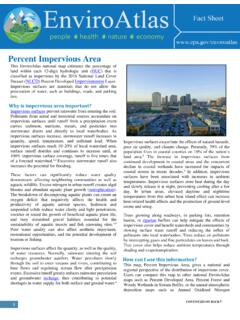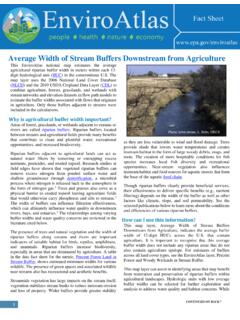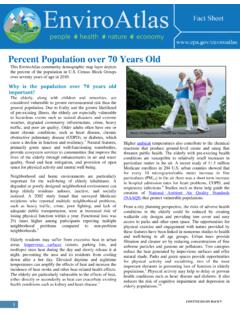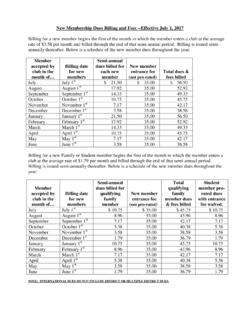Transcription of Average Annual Precipitation - US EPA
1 Average Annual Precipitation This EnviroAtlas national map estimates the Average Annual Precipitation from 1981 2010 in inches/year within each 12- digit hydrologic unit (HUC). It is based on the Parameter- elevation Regressions on Independent Slopes Model (PRISM) developed by the PRISM Climate Group at Oregon State University. Why is Annual Precipitation data important? Average Annual Precipitation amount is one of the major attributes characterizing the climate and associated ecosystem types and habitats of an area of interest.
2 Precipitation amount affects a region's stream density, water availability, land cover type, and agricultural productivity. For example, in the Great Basin, Average Annual Precipitation of 13 inches/year is indicative of a semi -arid climate with a desert shrub or sagebrush land cover. Great region's characteristic climate and surface water availability. Basin sagebrush habitats support a characteristic, associated Results of a study of Precipitation trends during the 20th group of plant and animal species representative of the century found a pattern of increased rainfall and streamflow ecoregion.
3 In the eastern half of the nation and decreased streamflow in Historically, Precipitation maps were drawn using isolines the West beginning in the (lines connecting equal points) connecting rain gauges The historical changes in Precipitation found in the eastern reporting equal Average Annual Precipitation amounts. Isoline and western are of interest to climate change research. Precipitation maps were a generalized estimation of Long term Precipitation data is necessary to model future Precipitation using available data.
4 Maps of this type were climate scenarios. Historical and current Precipitation data limited by the density and availability of gauging stations;. from various sources feeds climate models that project isoline maps may not accurately capture spatial and temporal global and regional rainfall amounts and distribution into the variability or the full effects of elevational changes on Studies have found that regional increases in Average Annual Precipitation . Precipitation amount and intensity are related to increases in Over the last several decades, with the development of temperature over recent decades.
5 Atmospheric water-holding computer mapping, Precipitation mapping has evolved to capacity increases by 7% with each 1 C increase in incorporate models of expected topographic variations in temperature and storms, supplied with more moisture, tend Precipitation . This EnviroAtlas map of Average Annual to increase in There is evidence of increasing Precipitation for the conterminous uses the PRISM intensity in rainfall events in the over the last several model that combines weather station data, elevation data ,5. from a digital elevation model, and regression equations to predict Precipitation for each grid cell in the digital elevation How can I use this information?
6 Model. Station observations used in the regressions are This EnviroAtlas national map, Average Annual weighted by factors such as distance, elevation, atmospheric Precipitation , depicts Average Annual rain and snowfall for vertical layering, aspect, and proximity to a the time period 1981 2010 in inches per year summarized by 12-digit HUC. The map is a modification of the PRISM map Of the many applications of Precipitation data, those most developed by the PRISM Climate Group with Precipitation pertinent to EnviroAtlas surround landscape character, expressed in inches/year rather than millimeters/yr and the surface water availability, and agricultural productivity.
7 Display altered to fit the EnviroAtlas national map HUC. With historical Precipitation data, researchers may search for framework. One may click on individual HUCs to see long term trends in Average Annual Precipitation relative to a estimated Average Precipitation within the HUC. The CONTINUED ON BACK. 1. Average Annual Precipitation map may be overlaid and What are the limitations of these data? compared with other EnviroAtlas maps depicting land cover The PRISM model was developed to provide a statistical and habitat, ecoregions, agriculture, or water supply and estimate of Precipitation amounts even in remote or demand to reveal how Precipitation levels relate to landscape mountainous areas not covered by weather station data.
8 It is character, ecosystems services, and productivity. based in part on an assumption of a linear relationship between Precipitation and elevation. Grid cells are fairly For example, one could relate this Precipitation map to coarse at 800 m (about mile). For EnviroAtlas, data regional water supply by comparing it with EnviroAtlas conversion from millimeters to inches, rounding of maps depicting number of major dams and water supply Precipitation amounts, and compilation by HUC further from reservoirs in millions of gallons (summarized by 12- altered the presentation of the original modeled data.)
9 As a digit HUC). The user can increase the transparency of the result, Precipitation estimates should not be expected to overlying map to examine the base map beneath and add match observational data for specific locations. data for streams and water bodies (NHDPlus, found under Hydrologic Features) to view the drainage network and the How can I access these data? potential locations of dams and reservoirs. EnviroAtlas data can be viewed in the interactive map, accessed through web services, or downloaded. How were these data created?
10 The Annual Precipitation values were estimated from maps Where can I get more information? produced by the PRISM Climate Group, Oregon State A selection of resources related to the importance of Average University. The original data was at the scale of 800 m grid Annual Precipitation data is listed below. For additional cells, representing Average Precipitation from 1981 2010 in information on how the data were created, access the mm. PRISM calculates a separate climate-elevation metadata for the data layer from the drop-down menu on the regression for each pixel.











